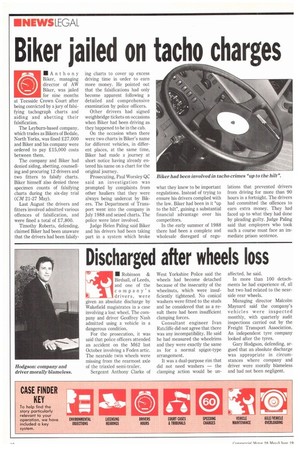Discharged after wheels loss
Page 14

If you've noticed an error in this article please click here to report it so we can fix it.
/ Robinson & Birdsall, of Leeds, and one of the company's drivers, were given an absolute discharge by Wakefield magistrates in a case involving a lost wheel. The company and driver Geoffrey Nash admitted using a vehicle in a dangerous condition.
For the prosecution, it was said that police officers attended an accident on the M62 last October involving a Foden attic. The nearside twin wheels were missing from the rearmost axle of the triaxled semi-trailer.
Sergeant Anthony Clarke of West Yorkshire Police said the wheels had become detached because of the insecurity of the wheelnuts, which were insufficiently tightened. No conical washers were fitted to the studs and he considered that as a result there had been insufficient clamping forces, Consultant engineer Ivan Ratcliffe did not agree that there was any incompatibility. He said he had measured the wheelrims and they were exactly the same as for a normal spigot-type arrangement.
It was a dual-purpose rim that did not need washers — the clamping action would be un affected, he said.
In more than 100 detachments he had experience of, all but two had related to the nearside rear wheels.
Managing director Malcolm Maynard said the company's vehicles were inspected monthly, with quarterly audit inspections carried out by the Freight Transport Association. An independent tyre company looked after the tyres.
Gary Hodgson, defending, argued that an absolute discharge was appropriate in circumstances where company and driver were morally blameless and had not been negligent.




















































































